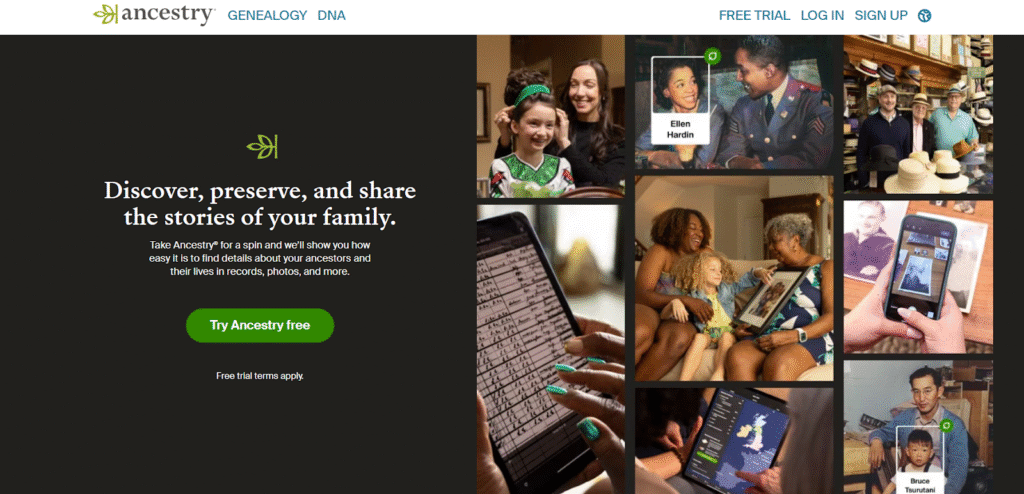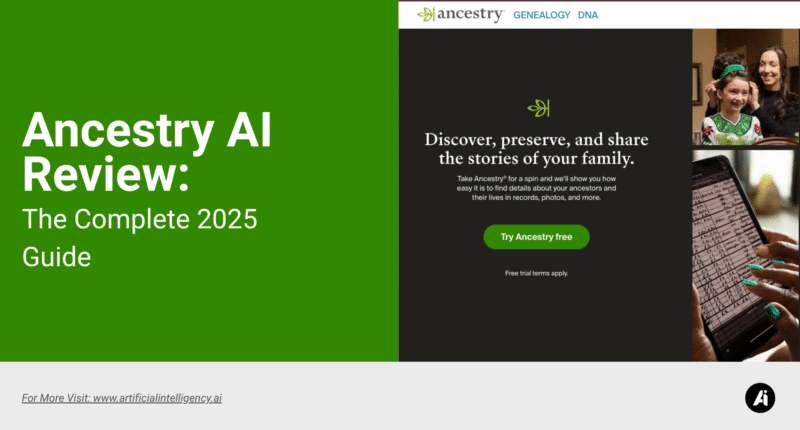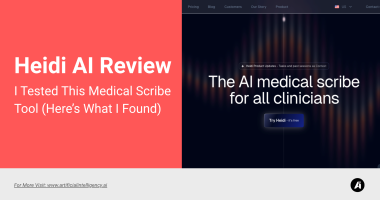Genealogy has always carried a special kind of weight. It’s not just about dusty records or faded photographs; it’s about discovering the human threads that connect us across time.
In recent years, artificial intelligence has been creeping into this world, quietly reshaping how people search for family ties.
And now, with the arrival of Ancestry AI, the process feels less like trawling through microfilm and more like stepping into a story.

This isn’t some casual update. Ancestry has spent years building technology that can process records faster, interpret handwriting, and even create narratives out of old documents.
The goal is clear: to make family history more immersive, more immediate, and less of a chore. But as with any leap forward, there’s a mixture of awe and caution.
Some features feel revolutionary. Others are still experimental, sometimes veering into uncanny territory.
In this review, I’ll look at what Ancestry AI is offering right now, why it matters to anyone exploring their roots, and how it stacks up as a tool for both researchers and curious families.
Along the way, we’ll touch on the promise, the drawbacks, and where this tech might be headed next.
Why Ancestry AI Matters?
For years, genealogy research has been stuck in a bottleneck. Millions of documents sat unprocessed because the sheer volume of handwriting, scanning, and cross-checking took months or even years.
Ancestry AI is shifting that equation. By applying machine learning to handwriting recognition and image processing, tasks that once stretched over nine months can now be done in just over a week.
That speed isn’t just about efficiency. It opens up more opportunities for people to uncover records that might otherwise have stayed buried.
Entire family trees can now be populated faster, with fewer gaps and delays. More importantly, AI makes the process approachable for everyday users who might not have the patience—or the expertise—to sift through endless archives.
It matters because family history is personal. Every advance that shortens the distance between someone and their great-grandmother’s birth record, or their ancestor’s immigration papers, turns research into connection.
Key Features of Ancestry AI
1. Easy Sign-Up & Onboarding

An underrated strength of Ancestry AI is how little friction there is to get started. The platform’s sign-up process is straightforward, guiding users through account creation, tree setup, and AI feature access without overwhelming them.
Even for people who aren’t tech-savvy, the onboarding flows naturally—almost like a step-by-step tour. Within minutes, users can start building their family tree, exploring digitized records, or testing out the narrative tools.
This accessibility is key, since genealogy has traditionally been seen as time-consuming and complicated. Ancestry AI lowers that barrier and makes the first step inviting.
2. Easy Free Trial

Another part that stands out is the availability of a free trial. Instead of asking for a big commitment up front, Ancestry AI lets new users test its core features before deciding on a subscription.
This makes it less intimidating to experiment with record searches, family tree tools, and some of the AI-driven experiences.
It’s a way to explore the platform’s strengths without feeling locked in, which is especially useful for casual users who are curious but not yet sure how deep they want to dive into genealogy research.
2. Access to Records on Ancestry

One of the strongest advantages of Ancestry AI is its direct connection to the massive archive already built by Ancestry.
Users don’t just get a slick AI tool—they gain access to billions of historical documents, from census data and immigration papers to military files and handwritten records.
The AI layers on top of this collection, making searches faster and results more accurate. This access turns Ancestry AI into more than a novelty feature.
It’s backed by one of the largest genealogical databases in the world, giving users both breadth and depth as they trace their family lines.
5. AI-Powered Record Processing
The backbone of the platform is its ability to scan and process records at a remarkable speed.
Handwriting analysis, image cleanup, and tagging are handled automatically, with humans still reviewing for accuracy.
This hybrid system means records are not only digitized faster but also catalogued in a way that’s more searchable.
6. Audio Stories and Narrative Generation
Beyond efficiency, Ancestry AI is experimenting with ways to bring history to life. One feature in testing is Audio Stories, where the AI can take scanned documents, family notes, and images, and weave them into spoken narratives.
It’s not just reading out facts—it’s presenting them like chapters of a personal story.
6. Immersive Ancestor Encounters
Perhaps the boldest feature being piloted is a VR-like experience where users can “meet” and interact with AI-generated versions of ancestors.
It’s emotional and eerie at the same time, giving people a chance to imagine conversations across generations.
While not yet polished, it points to a future where genealogy isn’t just about data but about re-creating presence.
Use Cases for Ancestry AI
The reach of Ancestry AI extends well beyond hobbyist genealogy. For individuals, it’s an entry point into personal history that feels less like research and more like connection.
Someone who has always been curious about their roots but intimidated by the technical side can now dive in with guided tools, fast searches, and AI-generated storytelling that turns facts into narratives.
Families who have boxes of old photos and documents tucked away can digitize them, tie them into records, and preserve them for future generations.
Educators are beginning to see potential in classrooms as well. Instead of teaching history through broad timelines, they can connect students to personal examples, showing how ordinary people lived through extraordinary events.
Community groups and local historians can also benefit. AI-driven record processing makes it feasible to organize archives that would otherwise take years to sort through, giving neighborhoods and cultural groups a more complete picture of their shared past.
Perhaps the most compelling use case is emotional: creating living connections across time. Hearing a narrative spun from an ancestor’s records or even experimenting with immersive VR encounters makes history tangible.
It changes family research from something dusty and academic into something immediate, personal, and often deeply moving.
After all, hearing a narrative spun from a century-old census record, or experiencing a virtual ancestor conversation, creates a kind of intimacy that spreadsheets of data never could.
This is where Ancestry AI steps beyond utility and into storytelling.
Pros and Cons of Ancestry AI
Pros
- Dramatically faster record processing, cutting research timelines from months to days
- Human review still in place, reducing the risk of error from pure automation
- Creative features like Audio Stories make genealogy engaging for wider audiences
- Experimental immersive tools push the boundaries of family history research
Cons
- Immersive ancestor encounters can feel uncanny or inaccurate, more novelty than research
- Still in beta stages—some features may glitch or deliver awkward results
- Ethical concerns around generating lifelike versions of deceased relatives
- Pricing and access may limit availability to casual users
Pricing and Plans
Cost is always a deciding factor, and Ancestry AI is structured with tiers similar to the broader Ancestry platform.
The free trial gives newcomers a risk-free way to explore features like basic tree-building, limited record searches, and some of the AI-powered tools.
From there, paid plans open access to the full database, advanced record collections, and premium AI experiences like Audio Stories and immersive encounters.
Pricing varies by subscription level, but the key draw is flexibility—users can choose the plan that matches how deeply they want to invest in genealogy.
Comparing Ancestry AI With Other Genealogy Tools
When compared with traditional genealogy platforms, Ancestry AI has an edge in speed and storytelling.
Competitors may offer access to records or tree-building software, but few have invested as heavily in artificial intelligence to process documents at scale.
Where Ancestry AI truly stands out is in its ability to turn raw data into something narrative-driven.
That said, some niche platforms may still excel in regional records or more academic-style research. For users looking for accessibility and immersion, though, Ancestry AI sets itself apart.
Ethical Considerations in Genealogy AI
The promise of “meeting” a virtual ancestor raises important questions. How accurate can these AI-generated conversations really be?
At what point does the line between historical record and creative fiction blur? While the technology can create moving experiences, it also risks oversimplifying or misrepresenting real people’s lives.
Ethical concerns also extend to privacy—living family members might be cautious about how much data they share.
Ancestry AI is treading new ground, and part of its responsibility will be to keep transparency front and center as these features evolve.
The Future of Ancestry AI
The trajectory of Ancestry AI is not just about making research faster—it’s about changing the entire experience of exploring family history.
Right now, features like Audio Stories and immersive ancestor encounters feel like glimpses of what’s coming, more prototypes than polished tools.
But if Ancestry continues to invest at the pace it has shown, we’re likely to see genealogy transformed from an archival process into something almost cinematic.
Imagine scrolling through your family tree and, instead of reading census notes, being able to watch a timeline unfold with sound, motion, and narrative weaving everything together.
A great-grandparent’s immigration story could be presented with historical context layered alongside personal details, turning facts into a lived experience.
Ancestry has already spoken about ambitions for “sight, sound, motion, and video storytelling,” which suggests we may soon move beyond static documents into immersive family history journeys.
At the same time, the future will hinge on balance. For this vision to succeed, accuracy must keep pace with innovation.
Users will want to be moved, but they’ll also want confidence that the AI isn’t inventing or over-romanticizing their history.
Privacy and ethical responsibility will remain constant guardrails too. If handled well, Ancestry AI could pioneer a model where technology doesn’t just preserve the past—it reanimates it in ways that connect generations more deeply than ever before.
Final Thoughts
Ancestry AI represents a bold shift in genealogy. For decades, tracing family roots was either a laborious personal effort or something left to dedicated researchers.
Now, the tools are arriving that make this journey more approachable, more engaging, and in some moments, surprisingly emotional. The ability to process massive amounts of data in days rather than months opens doors for people who might otherwise give up.
And features like Audio Stories prove that family history doesn’t need to stay locked in spreadsheets—it can be told, felt, and shared.
Of course, it’s not without its limits. The immersive ancestor encounters can sometimes feel experimental, even unsettling. Pricing may keep some of the most advanced tools out of reach for casual users.
And the ethical questions around simulating past lives will require careful, transparent answers. Yet even with those caveats, it’s hard to ignore how transformative the platform already is.
For anyone who has ever wondered about the people who came before them, Ancestry AI offers a bridge.
It may not have perfected every feature yet, but it signals a future where discovering your lineage is not just about building a tree—it’s about stepping into a story that has been waiting for you all along.
FAQs
What exactly is Ancestry AI?
It’s an AI-driven extension of the Ancestry platform, designed to process records quickly, interpret handwriting, and create storytelling experiences from historical data.
Does Ancestry AI replace human researchers?
No, humans still review records for accuracy. The AI is a tool to speed up and enrich the process, not replace expertise.
Is the immersive ancestor feature widely available yet?
Not fully—it’s still in beta testing. Some users have early access, but it’s not rolled out across all subscriptions.
How accurate are the AI-generated stories?
They’re built from real documents and data, but like any AI output, they can sometimes misinterpret or oversimplify. That’s why verification is important.
Can I try Ancestry AI for free?
Yes. A free trial allows you to explore core features before committing to a paid subscription.




